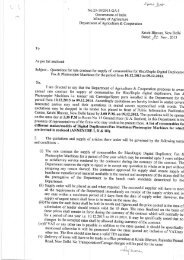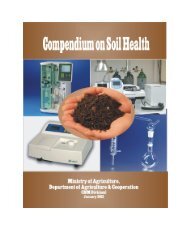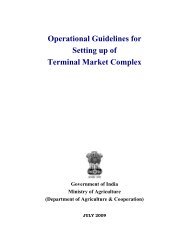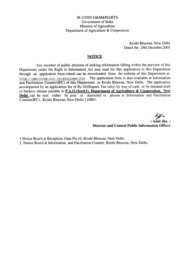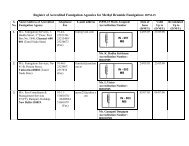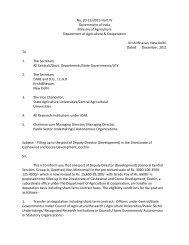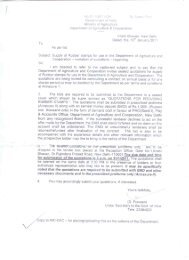Annual Report 2009-2010 - Department of Agriculture & Co-operation
Annual Report 2009-2010 - Department of Agriculture & Co-operation
Annual Report 2009-2010 - Department of Agriculture & Co-operation
You also want an ePaper? Increase the reach of your titles
YUMPU automatically turns print PDFs into web optimized ePapers that Google loves.
<strong>Annual</strong> <strong>Report</strong> <strong>2009</strong>-<strong>2010</strong><br />
72<br />
Macro-Management <strong>of</strong> <strong>Agriculture</strong> schemes:<br />
Assistance in the form <strong>of</strong> a subsidy at the rate <strong>of</strong><br />
25-50 per cent <strong>of</strong> the cost with permissible ceiling<br />
limits, is made available to farmers for the<br />
purchase <strong>of</strong> agricultural equipment, including<br />
hand tools, bullock-drawn/power-driven<br />
implements, planting, reaping, harvesting, and<br />
threshing equipment, tractors, power tillers and<br />
other specialised agricultural machines under the<br />
centrally sponsored scheme <strong>of</strong> Macro-<br />
Management <strong>of</strong> <strong>Agriculture</strong>.<br />
12.9 The feedback from state governments<br />
indicates that during the year <strong>2009</strong>-10 (up to 31<br />
December, <strong>2009</strong>), 2,612 tractors, 1,323 power<br />
tillers, 6,144 hand tools, 919 bullock-drawn<br />
implements, 2,208 tractor-driven implements,<br />
1,074 self-propelled/power-driven equipment,<br />
1,405 plant protection equipment, 691 irrigation<br />
equipment and 1,575 gender-friendly equipment<br />
are reported to have been supplied to farmers.<br />
12.10 Evaluation and Impact Assessment <strong>of</strong> the<br />
Plan Scheme-Promotion and Strengthening <strong>of</strong><br />
Agricultural Mechanisation through Training,<br />
Testing, and Demonstration: A study on the<br />
impact evaluation <strong>of</strong> the plan scheme, Promotion<br />
and Strengthening <strong>of</strong> Agricultural Mechanisation<br />
through Training, Testing, and Demonstration,<br />
was conducted by the <strong>Department</strong> <strong>of</strong> <strong>Agriculture</strong><br />
and <strong>Co</strong><strong>operation</strong> through the National<br />
Productivity <strong>Co</strong>uncil, Lodhi Road, New Delhi. The<br />
study report has been received by the DAC and<br />
the same has also been forwarded to all states,<br />
UTs, and FMTTIs for implementation <strong>of</strong> such<br />
recommendations, as and when they can be put<br />
in <strong>operation</strong>.<br />
12.11 State Agro-Industries <strong>Co</strong>rporations: The<br />
Government <strong>of</strong> India had advised state<br />
governments in 1964 to set up State Agro-<br />
Industries <strong>Co</strong>rporations (SAICs) in the public<br />
sector to act as catalysts in providing access to<br />
industrial inputs to farmers for their use in<br />
agriculture. Thus, 17 SAICs were set up in the<br />
joint sector with equity participation <strong>of</strong> the<br />
Government <strong>of</strong> India and the respective state<br />
governments <strong>of</strong> Andhra Pradesh, Assam, Bihar,<br />
Gujarat, Haryana, Himachal Pradesh, Jammu and<br />
Kashmir, Karnataka, Kerala, Madhya Pradesh,<br />
Maharashtra, Orissa, Punjab, Rajasthan, Uttar<br />
Pradesh, Tamil Nadu, and West Bengal, during<br />
1965-1970. Many <strong>of</strong> the state governments have<br />
increased their equity participation, as a result<br />
<strong>of</strong> which, the Government <strong>of</strong> India, at present, is<br />
a minority shareholder. SAICs have since<br />
expanded their basic functions by commencing<br />
with the manufacture and marketing <strong>of</strong><br />
agricultural inputs, implements, machines, aftersales<br />
service, promotion, and development <strong>of</strong><br />
agro-based units and industries. The Government<br />
<strong>of</strong> India is implementing a policy <strong>of</strong> disinvestment<br />
<strong>of</strong> its shares in SAICs, with a view to giving<br />
greater decision-making power to state<br />
governments by allowing for the transfer <strong>of</strong> its<br />
shares to state governments as per the following<br />
guidelines:<br />
Where the net worth <strong>of</strong> the SAIC is<br />
positive, the Government <strong>of</strong> India would<br />
be willing to consider <strong>of</strong>fering its shares<br />
to state governments at a price 25 per<br />
cent less than the book value <strong>of</strong> the<br />
shares, on the basis <strong>of</strong> the latest available<br />
audited balance sheet.<br />
In the case <strong>of</strong> SAICs whose net worth is<br />
negative, the Government <strong>of</strong> India would<br />
be willing to pass on its stake for a token<br />
consideration <strong>of</strong> Rs. 1,000 for the value<br />
<strong>of</strong> the shares.<br />
12.12 So far, the Government <strong>of</strong> India's shares<br />
in SAICs <strong>of</strong> Gujarat, Karnataka, Uttar Pradesh,<br />
Tamil Nadu, Rajasthan, and West Bengal have<br />
been transferred to the state governments<br />
concerned. The state governments <strong>of</strong> Madhya<br />
Pradesh, Assam, and Jammu and Kashmir have



